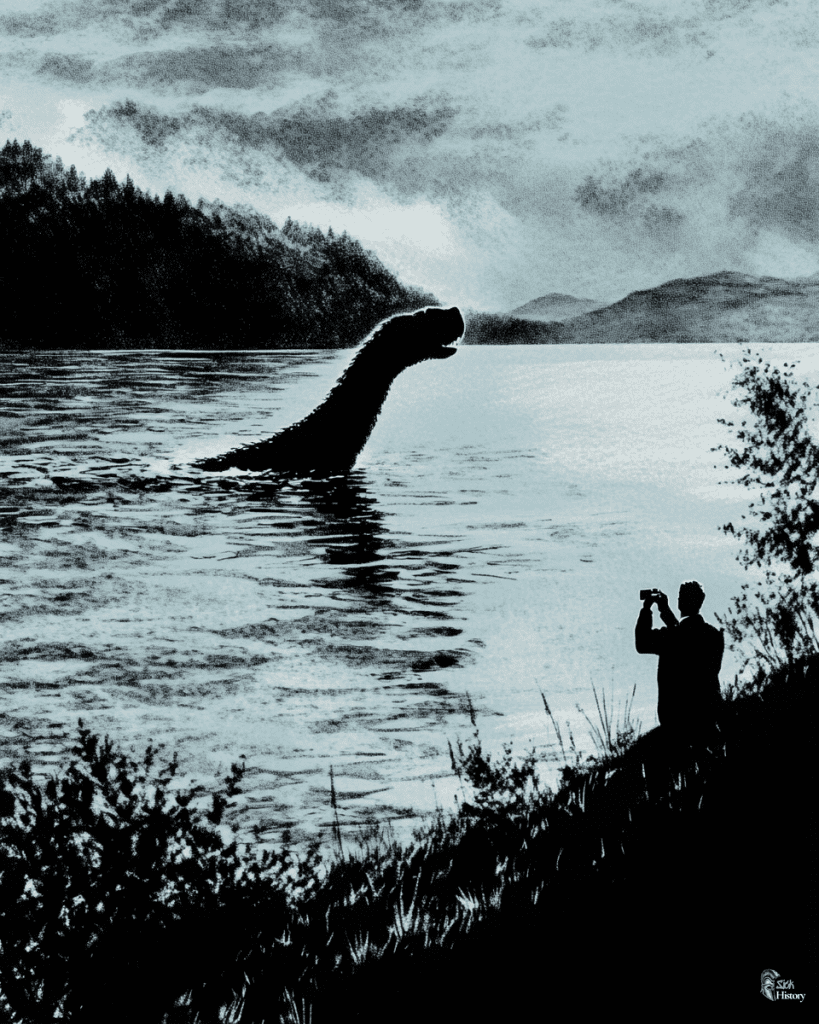The Loch Ness Monster, affectionately known as Nessie, has captivated imaginations for decades.
In 1934, a photograph emerged that would become one of the most famous images in cryptozoology. The “surgeon’s photograph” depicted what appeared to be the head and long neck of a mysterious creature emerging from the waters of Loch Ness.
The photograph, allegedly taken by Robert Kenneth Wilson, a London gynaecologist, was later revealed to be an elaborate hoax. The image was actually created using a toy submarine with a fabricated head and neck attached. This deception was orchestrated by Marmaduke Wetherell, who had been humiliated by a previous failed attempt to find evidence of the monster.
Despite the debunking of this iconic image, the legend of the Loch Ness Monster persists.
Numerous sightings, both before and after the “surgeon’s photograph,” have kept the mystery alive.
From sonar readings to eyewitness accounts, the Scottish Highlands continue to draw curious visitors who hope to glimpse the elusive Nessie.
The Surgeon’s Photograph
The Surgeon’s Photograph became the most famous image of the Loch Ness Monster.
Taken in 1934, it shaped public perception of Nessie for decades before being exposed as an elaborate hoax.
Creation and Exposure of the Hoax
The Surgeon’s Photograph was created as part of a carefully orchestrated deception.
In 1933, Marmaduke Wetherell, a big-game hunter, was hired to find evidence of the Loch Ness Monster. Wetherell sought to trick the press after being humiliated by the exposure of fake Nessie footprints he had discovered.
Wetherell enlisted his son-in-law, Christian Spurling, to construct a model monster.
He acquired a toy submarine and modified it with Spurling’s help. The miniature model was photographed in Loch Ness, creating the illusion of a large creature emerging from the water.
The hoax remained undiscovered for over 60 years.
In 1994, Spurling confessed to his role in the deception shortly before his death. This revelation shocked the public and exposed the true nature of the iconic image.
The toy submarine proved to be an ingenious tool in crafting one of the most enduring cryptozoological hoaxes.
Robert Kenneth Wilson and the Iconic Image
Robert Kenneth Wilson, a London gynecologist, lent credibility to the hoax by claiming to have taken the photograph. Wilson’s respected profession earned the image its “Surgeon’s Photograph” moniker.
Wilson claimed he captured the image while driving along the loch. He said he noticed a disturbance in the water and quickly took four photos.
Only two were reportedly clear, with the famous neck-and-head shot becoming iconic.
Wilson’s reluctance to have his name associated with the photograph added an air of mystery.
This hesitancy, combined with his professional status, made the image seem more genuine to the public. The photograph’s impact was significant, shaping the popular image of the Loch Ness Monster for generations.
Historical and Cultural Context
The Loch Ness Monster phenomenon has deep roots in Scottish history and culture. Reports of mysterious creatures in Loch Ness date back centuries, shaping local folklore and eventually attracting global attention. The legend has had a profound impact on tourism and the economy of the Scottish Highlands.
Early Sightings and the Loch Ness Phenomenon
Sightings of the Loch Ness Monster stretch back to ancient times.
In 565 AD, Saint Columba reportedly encountered a beast in the River Ness. Modern interest surged in the 1930s with several reported sightings.
In 1933, Hugh Gray captured a photograph of what appeared to be a large creature in the loch.
This was followed by the famous “Surgeon’s Photograph” in 1934, purportedly showing the monster’s head and long neck.
These events sparked widespread fascination and drew researchers, journalists, and tourists to the area.
Scientific expeditions using sonar and other technologies began searching for evidence of the elusive creature.
Influence on Scottish Folklore and Tourism
The Loch Ness Monster, affectionately known as “Nessie,” quickly became an integral part of Scottish folklore. The legend tapped into ancient myths about water creatures and captured the public imagination.
Nessie’s popularity led to a significant boost in tourism for the Scottish Highlands.
Inverness and the surrounding areas saw an influx of visitors hoping to catch a glimpse of the mysterious beast.
Local businesses capitalized on the phenomenon, offering Nessie-themed souvenirs, boat tours, and attractions.
The monster became a cultural icon, featured in books, films, and television shows worldwide.

